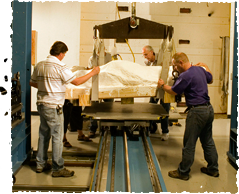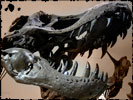National Geographic Channel
Dinosaurs
A Night of Dinosaur Discoveries
Dino Death Trap–Sunday, Dec. 9 at 8P et / 9P pt
Dino Autopsy–Sunday, Dec. 9 at 9P et / 10P pt
Dissecting a Dinosaur Mummy

Scientists and technicians load the Edmontosaurus block onto the giant scanner at Boeing.
When Dakota wasn’t grazing upon the lush vegetation of its ancient home turf, it may have spent much of its time running away from roaming Tyrannosaurs, who undoubtedly regarded the duckbills as a succulent repast. How precisely Dakota met its demise remains a mystery. But the discovery of a crocodile fossil alongside Dakota provides a clue about what happened after the dinosaur’s death, and how it came to be so well preserved, explains Tyler Lyson, who received a National Science Foundation fellowship and is now working toward his Ph.D. at Yale University.
“I think that Dakota died–who knows what killed it–and was on a sandbar or a river, being scavenged by the crocodile,” says Lyson, who is investigating the process by which dinosaur mummies are formed. “Then you had a rapid flood that buried the two of them together. The waterlogged sediment basically kept a fresh flow of iron coming to the decaying carcass where you had bacteria producing all this carbon dioxide.” The resulting chemical reaction created the iron carbonate tomb that encases the duckbill.
Autopsying an animal that’s been dead for millions of years, not surprisingly, is vastly more complicated than examining a fresh carcass. With the latter, “you can dissect, you can open the body cavity, shove your head in, have a look at the gore,” explains Manning. You can’t do it when it’s been mummified and is made of stone, which ours is. You’re going to need a CT scanner.”
“As far as I know, nobody’s ever tried to scan anything this huge”
And not just any CT scanner, either. To peer inside something as gigantic and dense as the rock in which Dakota is entombed, paleontologists had to seek help from aerospace giant Boeing’s Santa Susanna Field Laboratory, located 30 miles north of Los Angeles. There, Boeing has built a room-sized CT scanner that it uses to scrutinize Space Shuttle parts for potentially dangerous flaws–and, on occasion, to help paleontologists study dinosaur remains. In the late 1990s, for example, Boeing assisted researchers at Chicago’s Field Museum of Natural History by scanning the skull of Sue the Tyrannosaurus Rex. That imaging revealed, among other things, that the gigantic predator’s brain probably was not much larger than a quart bottle of milk, but that it had an enormous passage for olfactory nerves, suggesting that it had a highly developed sense of smell.
But scanning Dakota has been vastly more difficult, according to Boeing’s Jeff Anders, who is leading the effort. “As far as I know, nobody’s ever tried to scan anything this huge,” he explains. In order to scan Dakota, Boeing workers must first spend a half day dismantling a 14,000-pound wall so that they have room to ease the gigantic stone mass into the room with a forklift. Whenever the body block is moved–for example, when Boeing needs to use the scanner for a spacecraft part–for accuracy’s sake, it has to be set down in almost exactly the same spot as the last time it was scanned, within a margin of error that’s roughly the thickness of a sheet of paper. “It’s quite a major accomplishment just to do that,” he notes. Because Dakota’s stone tomb is six inches bigger than the largest object that the scanner was designed to accommodate, Boeing had to rewrite the instrument’s software to trick it into “putting a square peg into a round hole,” as Anders puts it.
at Boeing use the largest CT-Scanner on the planet. But will this high-stakes, high-tech paleontology work?



